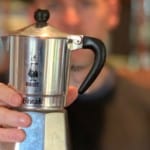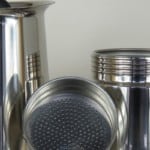So, What Is Moka Pot Coffee ?
Coffee prepared in a Moka pot is known as…
…Moka pot coffee. A Moka pot is a big vessel that looks similar…
…to a pitcher. It’s built of metal and makes a coffee that’s similar…
…to espresso. Moka coffee is a powerful full-bodied beverage.
It’s not a delicate brewing procedure…
…and it seems to work best with darker roasts. You’ll need to keep an eye…
…on the Moka pot and remove it from the heat…
…when the coffee is done to avoid spilling.
I don’t know how people live without coffee, I really don’t.”
Martha Quinn, actress.
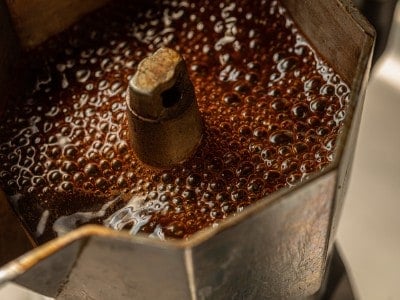
Here’s the main thing!
What is a Moka Pot?
The Moka Pot is an espresso-like coffee maker that can be used on a cooktop.
Because it employs boiling water to force steam through…
…the coffee grounds, rather than percolating down like brewed coffee…
…the coffee bubbles up into the pot. Alfonso Bialetti, an Italian engineer…
…designed the Moka Pot in 1933. Because it’s made by the Bialetti firm…
…some people just refer to it as a “Bialetti.”
It’s time to get technical: this isn’t actually espresso being made.
What we’re really making when we use a stovetop espresso maker…
…is Moka coffee in a Moka pot another name for a stovetop espresso maker.
Wow! That’s not true! While Moka coffee is similar to espresso…
…it is not the same as espresso made with an espresso machine.
The main difference between Moka coffee and espresso…
…is the lack of an aerated crema, as the water is not forced…
…through the grounds at as high of pressure as espresso.
However, for the sake of this post and since stovetop espresso makers…
…are often referred to as Moka pots and vice versa, we’ll use both terms…
…interchangeably. Just remember that they aren’t exactly the same!
The moka pot’s mechanism will be explained. When the moka pot…
….is placed on a stove, it heats up and creates steam, increasing the pressure…
…in the bottom chamber and pushing the water up…
…through the coffee grains into the top chamber.
In addition, stovetop espresso makers or moka pot…
…are sometimes called coffee percolators. Both coffee makers…
…share some similarities, but they’re actually quite different.
You can use a percolator to make coffee here. To learn more…
….about the differences between a Moka Pots and a regular espresso machine…
…read this head-to-head guide. But here, we have story…
…from Sammy’s of his experience having Coffee…
…from this tool as his daily consumption!
Let us hear Sammy’s story…
I went from consuming tea to become coffee every morning early last year.
Living in the messy world, social upheaval, and an uncontrolled society…
...made me want to change things up. I already have a Moka Pot at home…
.…so I’ve been using that. It’s not quite as simple as pouring boiling water over tea leaves…
…but it’s close. And after comparing my Moka Express to three other moka pots…
...I can see why it has such a cult following: it makes a strong, rich, espresso-like…
...batch of coffee in less than 10 minutes. To make a quasi-caffe latte…
…I combine the brew with simple syrup and milk. And it taste so amazing…
…best coffee type that I should recommend you about it while using Moka Pot.
After reading that story, you want to know more about this topic?
Read this article until the end, and you will know what Moka Pot truly is!
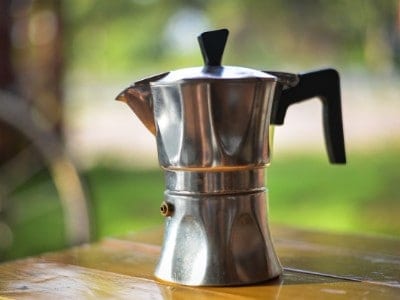
Go on…
How Do Moka Pots Work?
The moka pot, also known as stovetop espresso makers…
…uses basic physics to make the perfect cup of coffee. The machine…
…has three chambers: one for water, one for coffee grounds…
…and one for the finished blend. When the moka pot is placed on the stove…
…the water heats up and produces steam. Increasing the pressure…
…in the bottom chamber causes the water to rise through the coffee granules…
…and into the top chamber, where it can be poured. Its chambers…
…build up pressure of only 1.5 bars, far less than the nine bars achieved…
…in traditional espresso makers. Despite its simplicity, its ability…
…to make quality coffee made it a household favorite.
He is said to have been inspired by the sight of his wife doing laundry…
…in the 1930s to invent it. A bucket of soapy water was boiled over…
…the fire in their primitive washing machine. The dirty clothes…
…were wet after the water poured out of the tube. This same technique…
….was developed by Bialetti for his coffee pot, and the design has remained…
…very similar ever since. Over 300 million pots have been sold worldwide…
…since its release in 1933, and it remains…
…a staple among coffee enthusiasts everywhere.
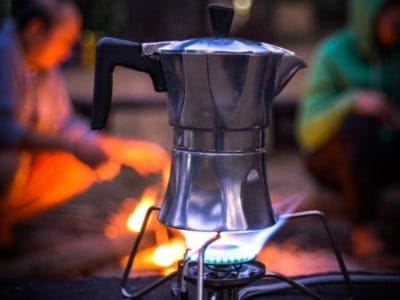
Keep reading…
How Long Does is Take to Make Stovetop Espresso?
Moka pots typically take around 5 minutes to make coffee. Taking into account…
…the time it takes to grind and prep, it usually takes about 15 to 20 minutes.
That does not include cleanup, which is essential if you want…
…to continue enjoying your moka pot coffee.
Caffeine Levels in Stove Top Espresso Coffee
Although many coffee drinkers genuinely enjoy their cups of joe…
…in reality, most of us have a secondary motive in mind: caffeine.
What is the caffeine content of Moka coffee and what is the difference…
…between Moka and espresso? For three different options of coffee…
…here are some caffeine facts:
- Cup of coffee (8 oz) = 105 mg of caffeine
- Shot of Moka coffee (2 oz) = 105 mg of caffeine
- Shot of espresso (2 oz) = 93 mg of caffeine
- NOTE: These quantities can vary dramatically.
It is easy to see that an 8oz cup of coffee has the same amount of caffeine…
…as a quarter of the amount of Moka coffee, and an equally sized shot…
…made with an espresso machine has even less. That’s right: a shot…
…of Moka pot coffee has more caffeine than a shot of espresso!
Moka coffee can tend to over-extract from the coffee grounds…
…compared to an espresso. So be prepared for some stronger coffee…
…with a higher caffeine content than usual. Drink responsibly!
In case you need recommendation…
…for best stovetop espresso maker, we have list for it.

Maintenance
The rubber seal and filters in moka pots must be replaced…
…on a regular basis, and the safety release valve must not be clogged.
When the rubber seal is fresh, it may change the taste of the coffee…
…so do a few “dry runs” without coffee or with used coffee grounds…
…to “prime” it. It is a common misconception that leaving coffee stains…
…in a moka pot is desirable; instead, the rancid coffee should be washed out…
…of the entire pot. In general, moka pots should not be washed in the dishwasher.
Running the pot through the dishwasher causes the protective oxidized…
…coating of aluminum to corrode and oxidize, leaving freshly exposed…
…aluminum to react with the air, resulting in a dirty, reactive…
…and blackened surface. Additionally, while brewing using the pot…
…after dishwasher use does not result in harmful levels of metal leaking…
…into the coffee, it does result in a higher aluminum content leaching…
…into the coffee. It is suggested that you use a moderate detergent.
Moka Pot Dimensions
The size of the moka pot is determined by how many 50 ml…
…2 imp fl oz; 2 US fl oz espresso cups it produces. The standard sizes…
…for the Bialetti Moka Express are listed in the table below.
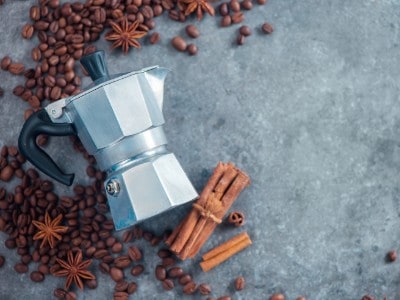
Moka Pot Coffee characteristics
The flavor of moka pot coffee is influenced by the bean variety…
…roast level, grind fineness, water profile, and heat level used.
The bean variety, roast level, grind fineness, water profile…
…and heat level employed all influence the flavor of moka pot coffee.
Moka pots, often known as stove-top espresso machines…
… produce coffee with a slightly higher extraction ratio…
…than standard espresso machines. A regular moka pot coffee…
…on the other hand, is extracted at modest pressures of…
…1 to 2 bar (100 to 200 kPa), whereas espresso coffee requires…
…a pressure of 9 bar (900 kPa). As a result, moka coffee…
…is not regarded an espresso and has a distinct flavor profile.
Sum up
The moka pot has been tucked away in the cupboards of every Italian kitchen…
…for nearly a century, but I only got one a few months ago. I’ve spent a lot of time…
…trying to get it right: if you don’t keep an eye on it, this brewer…
…will make bitter coffee, and there’s no established recipe with dosage…
…recommendations (in grams). I’ve fallen in love with this fantastic brewer…
…while trying to find my own path. It’s inexpensive, attractive…
…and capable of producing excellent coffee.
Conclusion
To sum it up, the Moka Pot is a very rewarding brewing technique when used correctly.
It produces a velvety, full-bodied cup with richer notes and mouth feel…
…than a V-60 or Aeropress. Simply keep an eye on the clock. That’s all I’ve got for now!
Is there anything else you’d like to know about the moka pot?
or would you like to add a method for brewing coffee with a Moka Pot?
Simply tell us in the comments section below! Thank you…
…for taking the time to read this! Cao!
Was this helpful?
Hi there! I’m a food enthusiast and journalist, and I have a real passion for food that goes beyond the kitchen. I love my dream job and I’m lucky enough to be able to share my knowledge with readers of several large media outlets. My specialty is writing engaging food-related content, and I take pride in being able to connect with my audience. I’m known for my creativity in the kitchen, and I’m confident that I can be the perfect guide for anyone looking to take their culinary journey to the next level.

